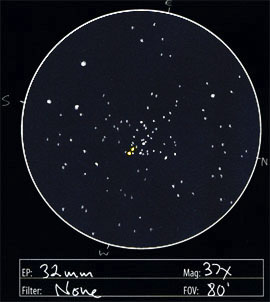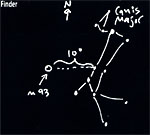
Observation Notes:
 This is a triangular arrow shaped cluster with its tip pointing southwest. This southwest tip hosts one orange and one yellow star. In the center lies a trapezium-like arrangement of stars. The main body appears to be 16' in diameter. The brightest neighboring star lies 30' to the southeast.
This is a triangular arrow shaped cluster with its tip pointing southwest. This southwest tip hosts one orange and one yellow star. In the center lies a trapezium-like arrangement of stars. The main body appears to be 16' in diameter. The brightest neighboring star lies 30' to the southeast.
Factoids:
M93 lies 3600 light years away and its 80 or so member stars span 20-25 light years across. Its brightest stars are B9 Blue Giants, and its age is estimated at 100 million years. While its stars form a triangular shape, Kenneth Glyn Jones found it to look like a butterfly, while Admiral Smyth found it more like a starfish. It was one of the last deep sky objects discovered by Charles Messier personally and was cataloged in 1781.
| Subject | M93 (NGC 2447) | |
| Classification | Open Cluster | |
| Position* | Puppis [RA: 07:44.6 / Dec: -23:52 | |
| Size* | 22' | |
| Brightness* | 6.0 | |
| Date/Time | February 4, 2005 - 9:15 PM (February 5, 2005 - 04:15 UT) | |
| Observing Loc. | Flagstaff, AZ - Home | |
| Instrument | Orion SVP 6LT Reflector (150 mm dia./1200 mm F/L) | |
| Eyepieces/Mag. | 32 mm (37X) | |
| Conditions | Clear, 29°F | |
| Seeing | 2/10 | |
| Transparency | Mag 5.0 | |
| Sources | SEDS |
*Based on published data.




